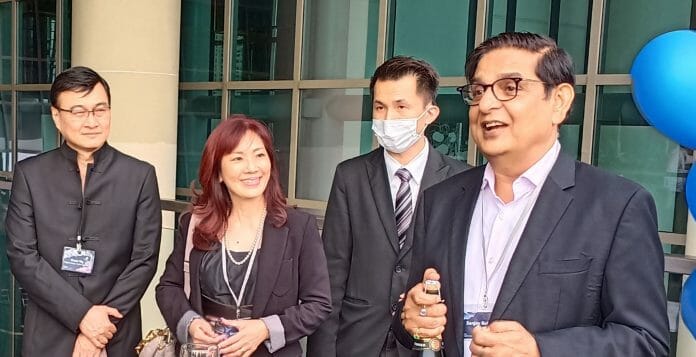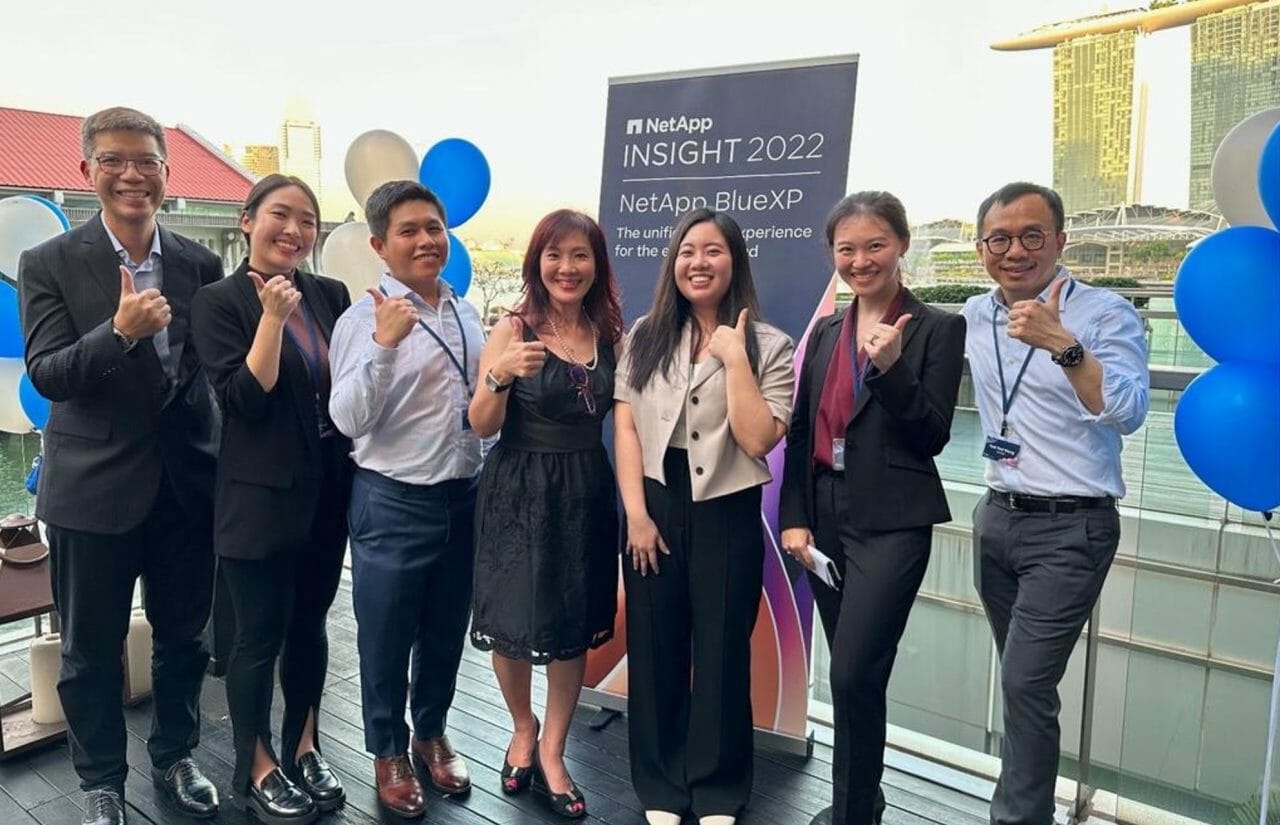According to Sanjay Rohatgi, Senior Vice President and General Manager for NetApp Asia Pacific and Japan (right in pic), NetApp’s customers have benefitted from the synergy between the company’s technology and that of its partners.
“NetApp has transformed from a legacy enterprise storage company into a global cloud-led data-centric software company. We are growing on both pillars and driving the strategy on three pillars; one is enterprise storage, which is the old on-premise (on-prem) storage; the second is the cloud storage; and the third category, which we’re creating through acquisitions, is the whole area of cloud ops.”
Rohatgi pointed out that for NetApp, the cloud front has been doing very well. “I think it’s the relationships which we have carved out with the hyperscalers that have been helping us and helping our customers as well. On any demanding workloads like SAP or complex databases, they prefer to use NetApp cloud storage than their own native storage.”
“We have relationships with (Microsoft) Azure; our solution there is called Azure NetApp Files. With AWS (Amazon Web Services), we have an offering called FSx for ONTAP. And with Google Cloud Platform (GCP), we have a first-party service called Cloud Volumes Service. We have natively integrated into the hyperscalers these first-party services that they can actually go and sell, and they do.”
He said this during a media briefing held in conjunction with NetApp INSIGHT 2022, the company’s customer conference, where the company delved deeper into its new branding “for the love of cloud”. This year 2022 also marks the company’s 30th anniversary.
“The world is going to move into hybrid multi-cloud. NetApp has built its innovation over a 30-year period – we were formed in 1992 – and now we’re all about how we can help our customers with their digital transformations enabled by the cloud. Because of environmental and economic factors, I honestly feel that there will be faster adoption of the cloud, because the cloud actually delivers on a lot of the promises and on what our customers expect. We continue to help our customers transform for a cloud-native future with really strong partnerships and ecosystem with the hyperscalers.”
Rohatgi also highlights the fact that NetApp’s strong partnerships with the three major hyperscalers also indirectly help its customers reduce emissions and make the data more sustainable in a variety of ways.
“One is optimised cooling; evaporative cooling using recycled water consumes less energy (therefore less carbon emissions). Renewable energy is very key – all the three hyperscalers in the next 5 to 10 years will only use renewable energy for powering their datacentres; they will move away from conventional carbon-based energy system. That is a very conscious effort from them, moving to completely renewable energy; and that’s a big thing, because datacentres are big energy hoggers. And last but not least is transparency of CO2 emissions. Hyperscalers will generally provide customers with tools to help them track their environmental impact; how much CO2 emissions and the like that their data are producing, and how they can optimise it further.
“Our successes both financially and in terms of sustainability are possible not only by innovating ourselves on data analytics, infrastructure analytics, storage and services, and Spot; the partnership which we have is a combined effort. We cannot do it on our own; we have to partner in this industry to make sure that our data is much more sustainable. Enterprises can partner with NetApp and its partner base to look at sustainability as a key theme moving forward.”
Rohatgi is upbeat about NetApp’s achievements over this time period.
“We continue to deliver good financial results. For FY22, our revenue was $6.32 billion. In Q1 of FY23, on all metrics we had a big tick, whether it’s EPS (earnings per share) or revenue growth. But what I’m most excited about is the cloud numbers, which is at $584 million growing at 70% year-over-year. And that is the area that we want to focus more and more.”
He reiterates the fact that carbon neutrality and sustainability is top of mind for the company. “Sustainability and building a greener tech stack are very critical. Energy consumed by datacentres makes up a sizable chunk of total energy consumption. There’s tremendous amount of energy wastage when it comes to data storage. Research showed that only 32% of data stored is actually used, and 68% of the data is unused for a given enterprise. Now, this 68% cumulatively generates more carbon emissions than the airline industry.”
NetApp has outlined its commitment to achieve a 50% intensity reduction of Scope 3 Greenhouse Gas (GHG) emissions (produced by an organisation’s value chain) by 2030, and a 42% reduction of Scope 1 (controlled or owned by an organisation) and Scope 2 (electricity, heat, and cooling purchases) GHG emissions.
The company has also announced availability of new ways for companies to monitor, manage, and optimise their carbon footprints across their hybrid multi-cloud environments through several of their offerings.
“What we do is data-driven, so whatever the unused data is, that can be passed into tools that can look for unused data and passed into low-cost, low-energy-consuming datacentres. Spot by NetApp helps organisations operate more efficiently; it’s all about resource optimisation. The second one is infrastructure analytics; Cloud Insights is one of our acquisitions which helps organisations see and optimise compute and storage across on-prem as well as the cloud environment. Data analytics is managed through another solution offering called Cloud Data Sense, so that organisations and enterprises can see what they have, and how the data is being used or not. Less data to store and manage means less emissions. And finally, the storage service is our very own, NetApp ONTAP, which is the best operating system for storage in the world that helps organisations intuitively tier their data to cut emissions and costs.
“This is front and centre for us. We’ll continue to innovate to make managing their data more sustainable for our customers. All our solutions that are coming to fruition now look at simplicity, security, and sustainability. These three things are in mind when we design a new solution.”
Rohatgi firmly believes that NetApp can help enterprises unlock the best of hybrid multi-cloud IT architectures.
“More data has been created in the last few years than in the last few centuries. If companies can unlock the best of cloud, they can put this data to work with to accelerate their business. Hybrid multi-cloud is an inevitable reality; according to Gartner, 40% of enterprises will adopt hybrid multi-cloud architecture by 2025, compared to 2020 where the adoption was 10%. Fast forward another five years from 2025, adoption will be 70 to 75% of hybrid multi-cloud architecture. NetApp helps make enterprises journey to the cloud seamlessly.”
According to Rohatgi, NetApp’s next-stage ‘evolved cloud’ concept, as well as BlueXP, which the company bills as the next frontier for data management, is the result of the company’s cloud experience and its customers’ feedback.
“Over the last 15 years of cloud adoption, 3 trends have become clear. Cloud operations have become highly complex. They are not easy. Next, cyber risks have soared. Even in the last few years during the pandemic, the cyber-attacks or ransomware surpassed what you saw in the last two decades. Cyber risks are continually going to soar. Finally, cloud costs have ballooned out of control. Cloud is not cheap; cloud economics after a certain threshold become very expensive.
“As we listen to our customers, they’ve been telling us they want to look at simple, secure, flexible systems, and that’s exactly what we announced. Our customers tell us to give them simple, flexible access to the best attributes in their infrastructure.
“Most businesses today face the cloud through a siloed environment, security risks, and rising costs. Despite these challenges, we fundamentally believe that cloud has reached a turning point. In the next phase of the journey, which is what we have unveiled, what NetAppcalls the ‘evolved cloud’, cloud is poised to deliver on its full promise.
“The ‘evolved cloud’ is a strategic approach from NetApp for a hybrid multi-cloud environment, where the cloud is fully integrated into the enterprise operations. The evolved cloud lets enterprises focus on innovation, and it brings massive business advantage and scale, flexibility, and agility to our customers, irrespective of whether they’re using one or more public clouds, private clouds, hybrid clouds, or open-source frameworks. ‘Simplicity, security, sustainability, and savings’ is the new mantra for the cloud vision from NetApp.”
Meanwhile, Rohatgi states, NetApp BlueXP is a simplified and unified data experience for the evolved cloud or for a truly a hybrid multi-cloud environment.
“It is an integrated control plane that delivers a simplified hybrid multi-cloud experience, irrespective of where the data resides; be it on-prem, private cloud, public cloud, or multi-cloud. Here’s what enterprises get from BlueXP; simplicity, security, and sustainability, through intelligent monitoring across your hybrid and multi-cloud IT estates; and finally, BlueXP also enables savings through automation. These are the four tenets of BlueXP, and it is quite futuristic and forward looking, but we believe that the customers are going to benefit tremendously from the challenges they face to the cloud by adopting BlueXP as a unified control plane to manage the data set irrespective of where it resides.
“Nobody has got a unified control plane data management capabilities when the data is so dispersed. The whole idea is irrespective of whether the data is in AWS, Azure, or Google; private cloud, on-prem, we can move and manage the entire data set; you can activate new features, additional features, things like that from a single control pane on the data storage. Nobody has done it in the data management/storage domain, and that’s why when we compare to our peers, we are far ahead.”










